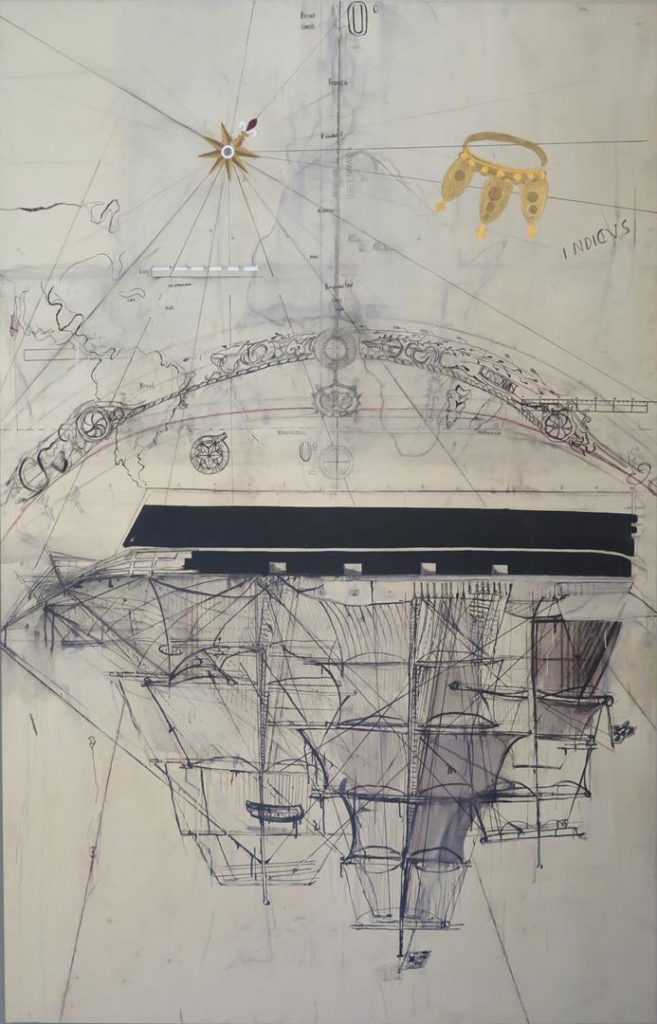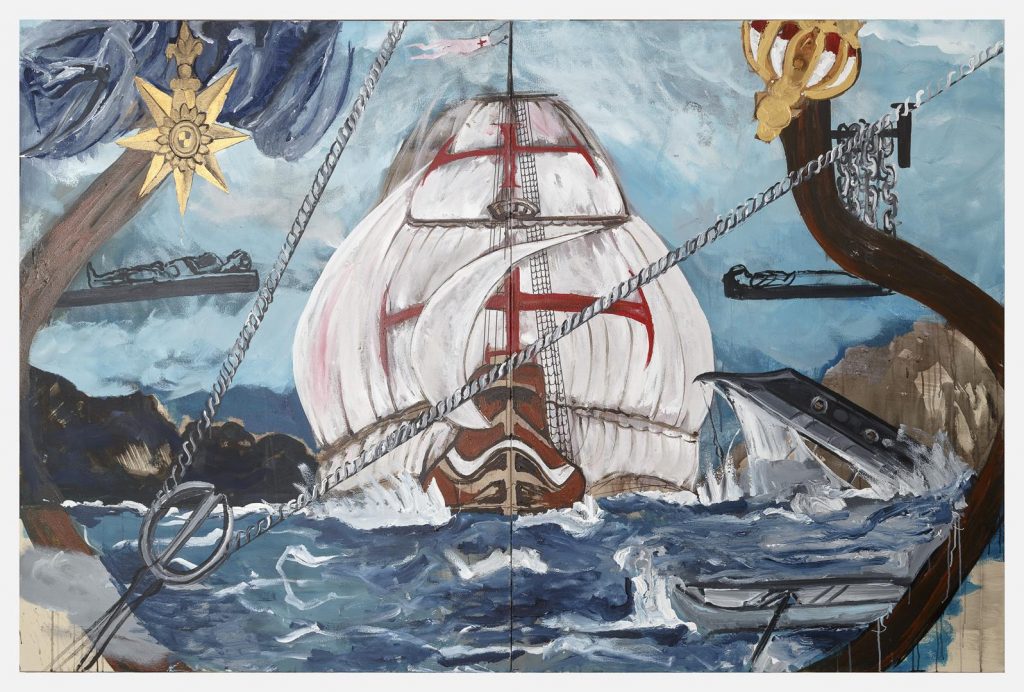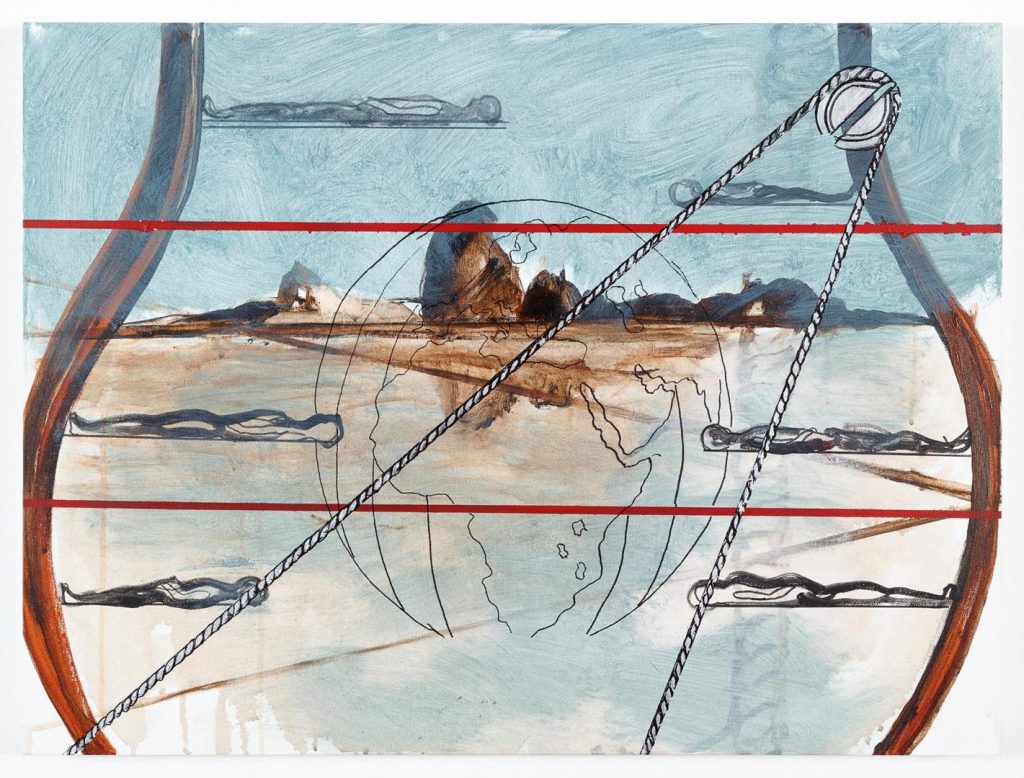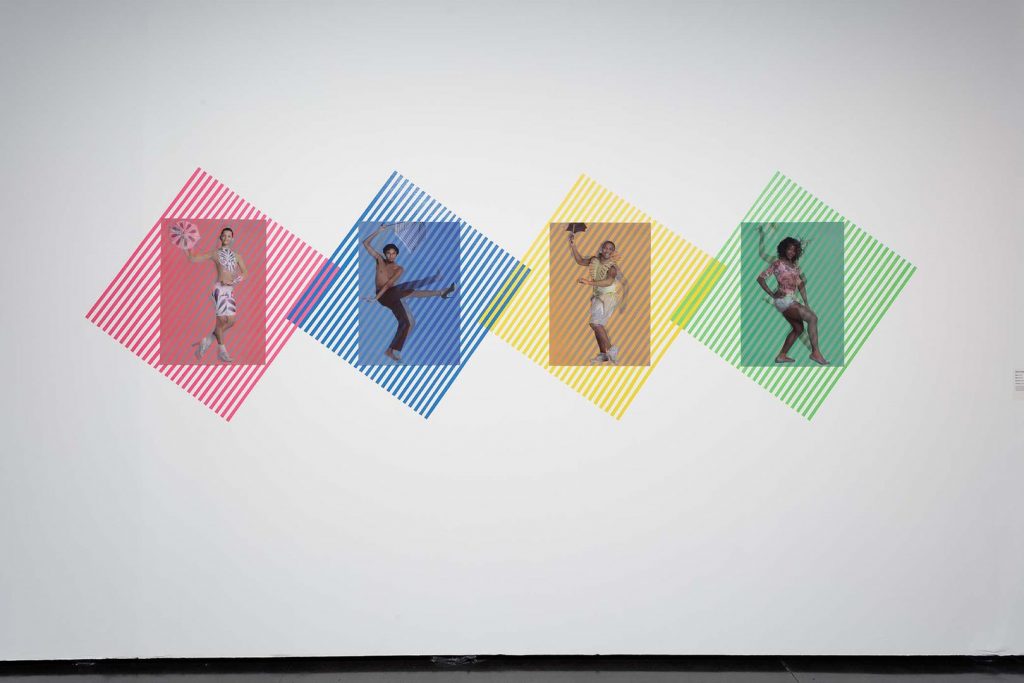2024
“PHYGITAL”
Centro Cultural PGE-RJ, Rio de Janeiro, Brazil
March 14 to July 13
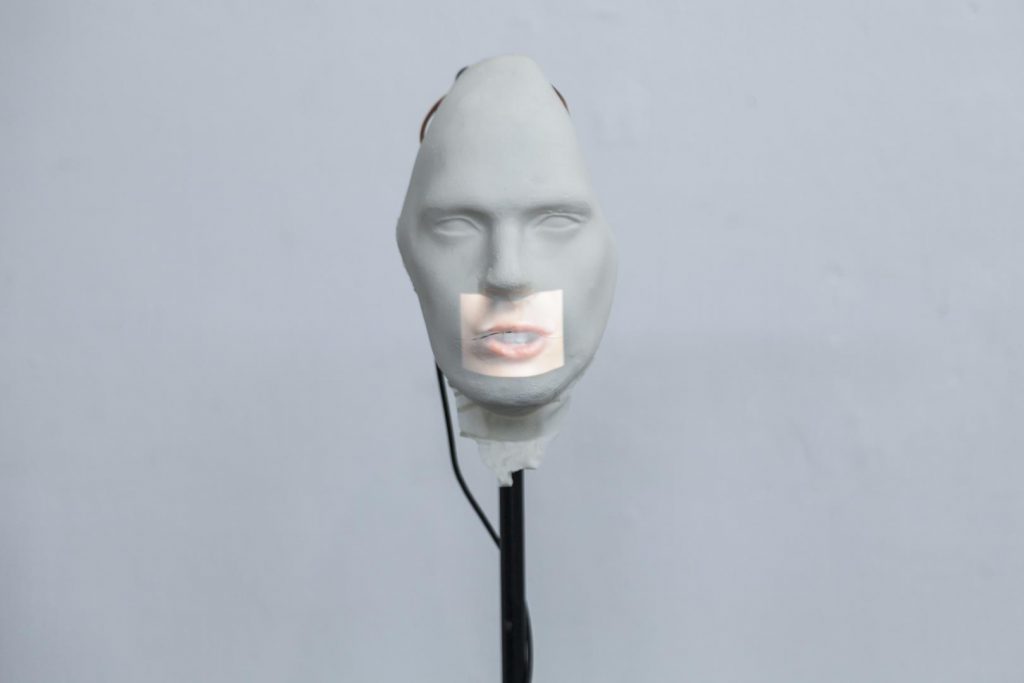
“Vedetes”, 2017, latex mask, microphone stand, iron, servomotor, arduino, projector, variable dimensions
About the exhibition:
The Cultural Centre of the Rio de Janeiro State Attorney General’s Office (PGE-RJ) is already preparing the new exhibition, “Phygital”, to open in mid-March. The theme of the new exhibition will be the hybrid real x digital universe and the issues that arise as a result of the increasingly intense use of technology in our daily lives.
2023
“Ah, eu amo as mulheres brasileiras”
Centro Cultural São Paulo, São Paulo, Brazil
July 08 to August 27, 2023
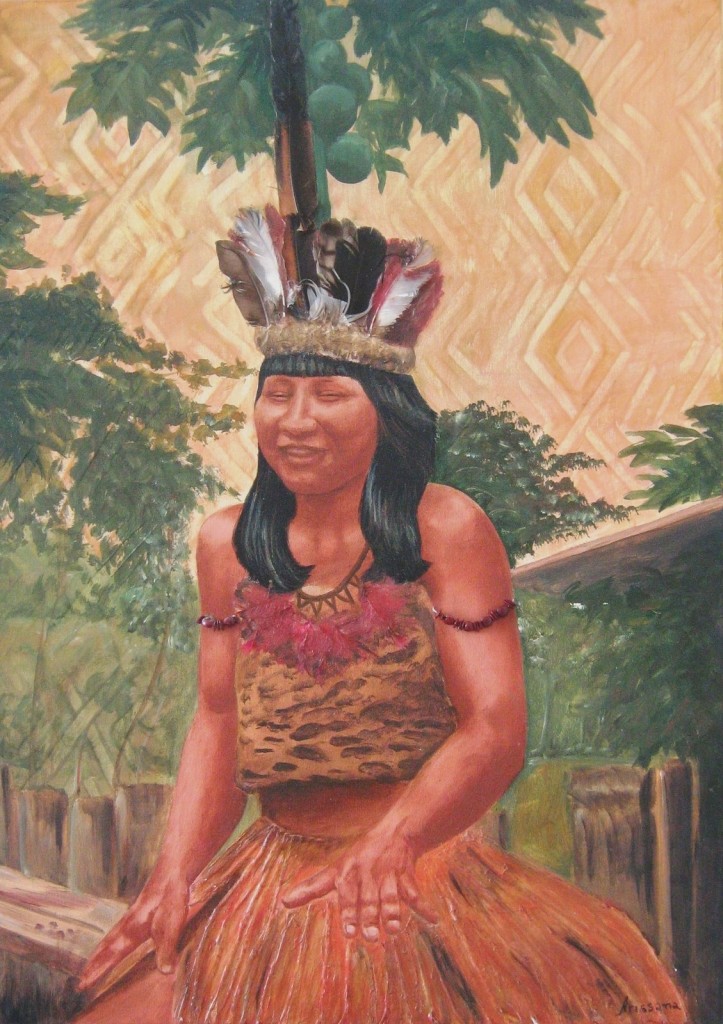
“Meruka”, 2007, mixture of techniques on the canvas, 70 x 50 cm.
About the exhibition:
“Ah, I love Brazilian women!” is an exhibition that reflects on the eroticization attributed worldwide to Brazilian women and criticizes this harmful stereotype that incites violence and sexualization.
The exhibition, curated by Luiza Testa, features works that illustrate the psychological and physical toll of the incessant objectification and dehumanization of Brazilian women’s bodies, especially black and indigenous women, a scenario that began during the period of colonization, through 20th century tourism to today’s political discourse.
Through contemporary art, photography, interventions and video-performances, the selected works delve into the inequalities that women bear in an attempt to transform collective pain into a reaffirmation of identity and common liberation. This approach is represented through the works of the following artists who are part of the exhibition: Arissana Pataxó, Berna Reale, Benedita Arcoverde, Brenda Nicole, Camilla D’Anunziata, Dalila Coelho, Juliana Manara, Lenora de Barros, Manuela Navas, Mari Nagem, Marta Neves, Micaela Cyrino, Milena Paulina, Raquel Pater, Santarosa Barreto, Terroristas del Amor, Vitória Cribb and Yacunã Tuxá.
Technical file
Curadora: Luiza Testa | Produtora: Lorena Oliveira Vilela | Artistas: Arissana Pataxó, Berna Reale, Benedita Arcoverde, Brenda Nicole, Camilla D’Anunziata, Dalila Coelho, Juliana Manara, Lenora de Barros, Manuela Navas, Mari Nagem, Marta Neves, Micaela Cyrino, Milena Paulina, Raquel Pater, Santarosa Barreto, Terroristas del Amor, Vitória Cribb e Yacunã Tuxá.
“Um oceano para lavar as mãos”
Sesc Quitandinha Cultural Center, Petrópolis, Brazil
April 15 to September 15, 2023
About the show:
Curators Marcelo Campos and Filipe Graciano have gathered approximately 40 works by artists Aline Motta, Arjan Martins, Ayrson Heráclito, Azizi Cipriano, Cipriano, Juliana dos Santos, Lidia Lisbôa, Moisés Patrício, Nádia Taquary, Rosana Paulino, Thiago Costa and Tiago Sant’ana, which will occupy a monumental space of 3,350 square meters.
“An ocean to wash your hands”, title taken from a verse of the song “Meia-noite” (1985), by Chico Buarque and Edu Lobo, proposes a review of the history of Brazil, thought by curators and black artists. The show also seeks to reflect on the city of Petrópolis, known as “imperial”, and which has a strong black memory.
Marcelo Campos says that in classes, bibliographies and various actions, there are “important historical reviews in Brazil, with the inclusion of black authors”. While in the 1990s African Americans were already “going straight to the wound”, he notes, in Brazil the initiatives were isolated. The public policies of the last 20 years, however, with quotas for black students, “in which UERJ was a pioneer”, and the penetration of universities in the interior of the country, such as Cariri and Recôncavo Baiano, have enabled blacks to gain access to various areas of knowledge. “This pressure forced academia and art spaces to change”.
He says he began to observe “the way black artists deal with the period of the navigations”. “This trauma, this tragedy of our society, displayed in the documentations in a normalized way, with illustrations of shackles, chains. Together with the artists, we thought about how to deal with it,” he says. “How art deals with the imaginary of the trauma of slavery, of the diaspora”. He mentions the research carried out by the English sociologist Paul Gilroy, a scholar of the black diaspora, and author of the book “Atlântico negro” (1993), a theme present in the works, and recalls that the artist Rosana Paulino, in a set of works from 2016, called “Atlântico vermelho”, in allusion to Gilroy, evoking the violence of slavery and its consequences until today.
Of the twelve invited artists, six were commissioned to create works especially for the exhibition: Azizi Cypriano, Juliana dos Santos, Moisés Patrício, Pedro Cipriano, Thiago Costa and Tiago Sant’ana.
Dos doze artistas convidados, seis foram comissionados para criarem trabalhos especialmente para a exposição: Azizi Cypriano, Juliana dos Santos, Moisés Patrício, Pedro Cipriano, Thiago Costa e Tiago Sant’ana.
Filipe Graciano, architect and urban planner, creator of the Museum of Black Memory, in Petrópolis, and coordinator of Promotion of Racial Equality of the Municipality, says that the expography will emphasize the idea of encounters contained in the multiple meanings that the word ocean brings. “The monumentality of the space of the Sesc Quitandinha Cultural Center meets the monumentality of black existence in Brazil”, he observes. Graciano points out the importance of the black curatorial look, with black artists, to tell “another story, other than the only one in Brazil”. “The potentiality of the hands, of washing history”. “The exhibition is almost an act of historical reparation,” he says, noting that the educational work will contribute to “rethinking the memory of the city”.
2022
“The Social Fabric: Art and Activism in Contemporary Brazil”
Visual Arts Center, Austin, Texas, USA
September 22, 2022 to March 10, 2023
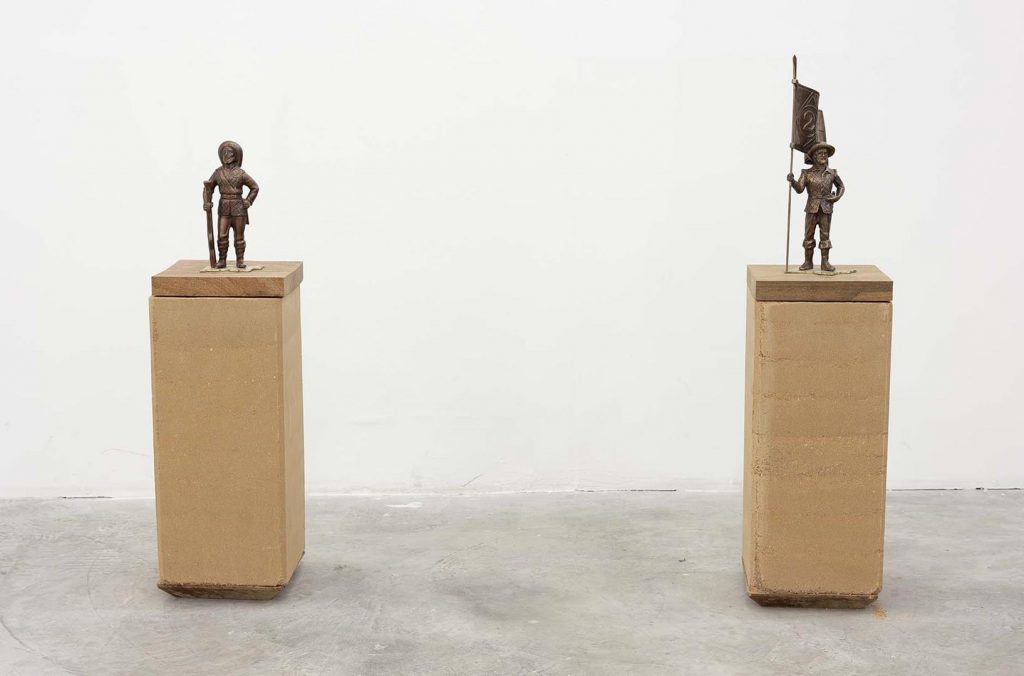
“Bandeirantes #1” and “Bandeirantes #2”, 2019, miniature monument in honor of the bandeirantes cast in brass and ammunition cartridge used by the Military Police and the Brazilian Armed Forces on a base built in taipa and pilão.
The Visual Arts Center at the University of Texas at Austin presents Social Fabric: Art and Activism in Contemporary Brazil. The show brings together the work of 10 artists from Brazil who reflect on the persistent histories of power structures in Brazil
Organized by Adele Nelson, assistant professor of art history at the University of Texas at Austin, MacKenzie Stevens, director of the Center for Visual Arts, and María Emilia Fernández, assistant curator, Social Fabric features artists who see art as a platform for critical engagement with historical, political, and cultural configurations of place, contributing to both local and global conversations about the democratic conjuncture, refusing to maintain neutrality, and illuminating histories of state-sanctioned oppression and ongoing inequality. Artists participating in Social Fabric offer different approaches to activism, forging paths towards justice and healing.
The exhibition encompasses a wide range of media, including installation, painting, performance, photography, sculpture and video, and features more than 60 artworks, many of them newly commissioned. The exhibition can be visited until March 10, 2023. It will then be exhibited at the Museum of Contemporary Art of the University of São Paulo (MAC USP), Brazil.
Artists: Aline Motta, Antonio Obá, Castiel Vitorino Brasileiro, Denilson Baniwa, Guerreiro do Divino Amor, Jaime Lauriano, Lais Myrrha, Maré de Matos, Rosana Paulino, Sallisa Rosa
2020
“HISTÓRIAS DA DANÇA”
MASP, Rio de Janeiro, Brazil
June 25, 2020 to November 5, 2020
Histórias da dança is a group exhibition that was scheduled to take place between June 25 and November 5, 2020 at MASP. Due to the Covid-19 global pandemic, the exhibition – which would have brought together more than 250 works by 160 artists, choreographers and performers from different periods, geographies and typologies – was canceled due to budget cuts, logistical complications and international travel. This website presents a very partial record of what the exhibition would have been like, with a selection of works divided into nuclei and abbreviated versions of the respective essays. The full texts, as well as a complete list of the works, can be found in the catalog edited by Adriano Pedrosa, Julia Bryan-Wilson and Olivia Ardui.
Rather than proposing a chronological narrative on the history of dance, or even an exhaustive journey on the relationship between dance and the visual arts, the exhibition Histories of Dance proposes a reflection on the politics of the body in movement. Previous exhibitions have investigated historical moments in which dancers and artists collaborated closely, such as the Ballets Russes or the Judson Dance Theater. This exhibition is structured around key terms in dance thinking – improvisation, tension, composition, gravity, among others – thought of from a broad perspective of how bodies relate and move in space and time.
Approaching dance in its broadest sense of socially constructed and codified movement, Histories of Dance includes gestures not necessarily associated with dance: transgressive expressions of marginalized subjects, coordinated and disciplined locomotion, insurgent gestures and the subversive occupation of public space. The exhibition also includes protest videos or street dances that have gone viral on social networks or platforms such as Youtube. The project also highlights the importance of Latin American kinetic art and Brazilian neo-concrete art at the center of these debates, investigating the political implications of collective movements.
From pre-Columbian archaeological materials, through the rhythm of early 20th century abstract canvases, to contemporary choreographed protests, Dance Histories celebrates dance’s potential to express joy and physical desire – and also collective anger – in the face of oppression and crisis. While historical representations of dance have often presented exoticized images of Others, this exhibition emphasizes the self-invention and assertive claiming of territories by black and indigenous bodies moving together in space. In addition, Histories of Dance highlights the contribution of women, with special attention to feminist and queer perspectives – from Chilean women’s mourning for those disappeared under the Pinochet regime in the dance-protest cueca sola, to the pioneering work of dancers such as the Brazilian Analivia Cordeiro or the African-American Josephine Baker (1906-1975). By highlighting the way bodies move together within specific political, historical and economic contexts, the exhibition presents dance as a form of exuberant resistance.
Of fundamental importance to the show is an open space, an arena, commissioned for the artist Carla Chaim, where an intense program of performances, presentations, rehearsals and workshops would take place in the second basement of MASP. The presence of moving bodies at the heart of the exhibition allows us to critically question the possibilities, dialogues and fissures that can arise when dance enters the museum.
CURATOR Adriano Pedrosa, artistic director, MASP; Julia Bryan-Wilson, assistant curator of modern and contemporary art, MASP; Olivia Ardui, assistant curator, MASP.
2019
“21ª Bienal de Arte Contemporânea Sesc_Videobrasil | Comunidades imaginadas”
Galpão VB, São Paulo, Brazil
October 9, 2019 to February 2, 2020
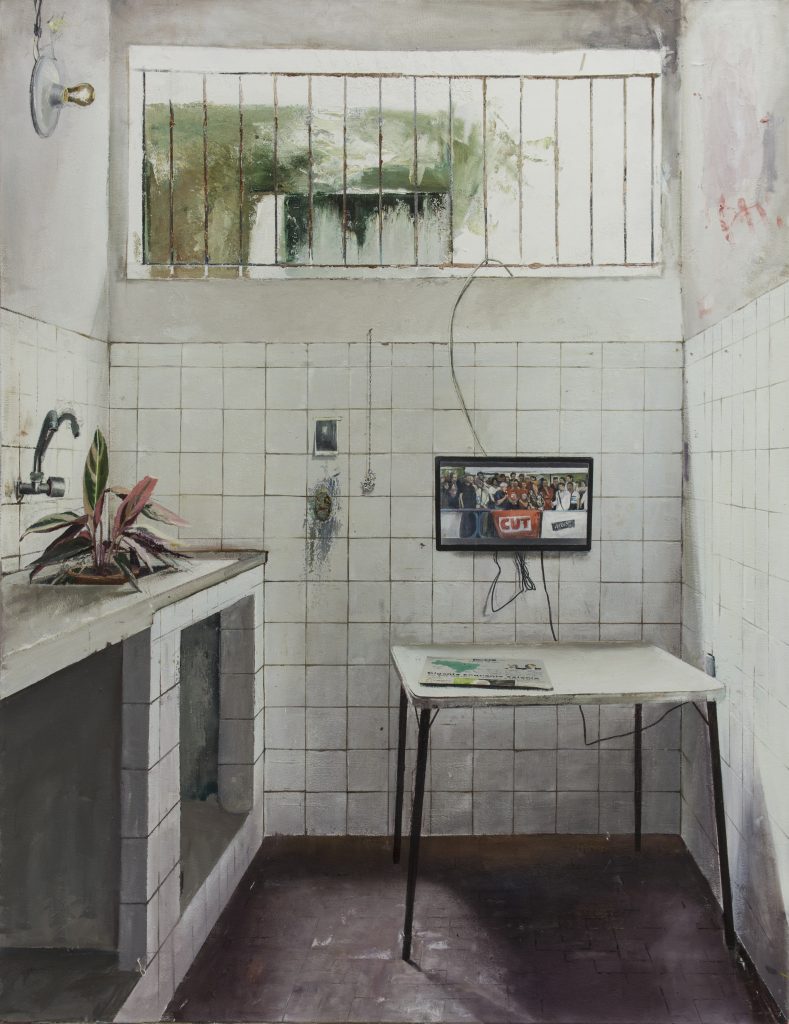
“O Golpe, a prisão e outras manobras incompatíveis com a democrácia”, 2018, oil on canvas, 146.5 x 113 cm.
ANDRÉ GRIFFO (Brazil, 1979) is an artist who graduated in architecture and urbanism from the Santa Úrsula University (2004) and has dedicated himself entirely to the arts since 2009. He works with painting, installation and drawing, exploring cracks in the fabric of Brazilian society. To do this, she often uses historical and iconographic references from the country’s recent and distant past. Her solo exhibitions include Objetos sobre Arquitetura Gasta, Centro Cultural São Paulo (2017); Intervenções Pendentes em Estruturas Mistas, Palácio das Artes, Belo Horizonte (2015); and Commando, for the Fernanda Perracini Milani Art Gallery, Jundiaí City Hall, São Paulo (2015). Group exhibitions include Ao Amor do Público I – Doações da ArtRio (2012-2015); MinC/Funarte, MAR, Rio de Janeiro, (2014); and Instabilidade Estáve, Paço das Artes, São Paulo (2014). At the 21st Contemporary Art Biennial Sesc_Videobrasil, the artist presented three paintings:
O GOLPE, A PRISÃO E OUTRAS MANOBRAS INCOMPATIBLE COM A DEMOCRACIA (2018) The work depicts the moment of former president Lula’s speech before his arrest in 2018, on the platform set up in the courtyard of the ABC Metalworkers’ Union, in the city of São Bernardo do Campo, an emblematic space of the struggles for the return of democracy in Brazil at the end of the military regime. Framed by a television set, the image highlights the instances of mediation between the public and the political event in question. In this way, the painting mobilizes the historical genre in times of fake news, narrative conflicts and the dispute for hegemony between social media networks and traditional telecommunication vehicles.
TRAVELLING TIMES AND SEEING THE SAME THINGS (2017) The images in this work are part of the artist’s iconographic research into Brazil’s colonial and imperial periods in photographs, paintings, drawings and architectural records. The characters in these images – the patriarch, the wife, the children, the slaves, the bastard son, representatives of the church and politicians – are references for narratives that, as well as exposing Brazil’s social structure in the past, illuminate the social inequalities of the present and testify to the immutability of the state of affairs in the country. The work is part of the series with the same title.
UMA COR PARA CADA ERRO COMETIDO (2017) The work is part of the series Percorrer Tempos e Ver as Mesmas Coisas, in which the artist starts from iconographic research about Colonial and Empire Brazil, investigating photography, architecture and the arts of that historical moment, taking the imagery of a decadent but permanent big house to private environments. He thus explores the vicious resilience of a social structure that survives historical evolution.
2018
“FRATURA”
Instituto Tomie Ohtake, São Paulo, Brazil
March 15, 2018 to May 6, 2018
A exposição “FRATURA” propõe, a partir das obras de Adriano Costa, Arjan Martins e Juliana Cerqueira Leite, o questionamento das urgências do tempo presente e seu apego à própria descartabilidade.
Em suas obras, o paulistano Adriano Costa lança mão de objetos e imagens banais, hoje produzidos, consumidos e supostamente esquecidos, para, como aponta a curadoria, recombiná-los até a lógica dos produtos fraturar o fazer artístico e vice-versa.
“Com o ar pesado demais pra respirar”
Galeria Athena, São Paulo, Brazil
March 20, 2018 to November 24, 2018

“O Golpe, a prisão e outras manobras incompatíveis com a democrácia”, 2018, oil on canvas, 146.5 x 113 cm.
Galeria Athena is pleased to present the group show With the air too heavy to breath, curated by Lisette Lagnado.
André Griffo | Anna Bella Geiger | Antonio Dias | Antonio Manuel | Artur Barrio | Débora Bolsoni | Franz Weissmann | Frederico Filippi | Hélio Melo | Igor Vidor | Iole de Freitas | Iza Tarasewicz | Joana Cesar | Lais Myrrha | Laura Belém | Leonilson | Leticia Parente | Matheus Rocha Pitta | Raquel Versieux | Rodrigo Bivar | Rubens Gerchman | Vanderlei Lopes | Yuri Firmeza
What Now?
On the eve of presidential elections, the “human conviviality standards” of the “cordial man” find Brazilian society bisected by hate speech. Settled on the belief in a diverse tropical country, Sergio Buarque de Holanda’s post-colonial social theory of Brazil (1936) collapsed in the face of current rates of violence and homicide against young and poor (trans, black and indigenous) populations. Over six months have elapsed since the murders of Rio de Janeiro’s councillor Marielle Franco (PSOL-RJ) and driver Anderson Gomes with no indictments of those responsible for the crimes by justice.
It matters to know how this awareness translates into artistic language creation. In recent months, thematic exhibitions on the current democratic setback have multiplied, comparing present time to 1964’s military coup and its toughening after the enactment of AI-5, in 1968.
The show “Com o ar pesado demais pra respirar” (Air Too Heavy to Breathe) seeks to make a statement on the atmosphere of this comprehensive times of unique distress. With an invitation to show at a gallery which is opening a new venue at the south district of Rio de Janeiro (a state under federal intervention in public security since the beginning of the current year), I’ve asked each artist how the news have been reflecting on their daily lives, their mindset and their actions. I’ve received erratic reports, ranging from expression breakdown, to nihilism, and lack of concentration. After all, Athena Arte Contemporânea’s artists lived their age of majority while the country had a leftist government who has made poverty and hunger reduction their main agenda. What now?
The title of the exhibition was inspired by a work by Frederico Filippi, comprised of two galvanized steel sheets covered in black ink and other mixed media, such as oil, charcoal, spray paint, and pieces of paper covering scratched inscriptions. Given his background in aviation, the artist extracted from this repertoire the word “estol” (“stall”), which means the airplane’s loss of support, the moment when it “suffocates”. “It goes higher and higher until it can’t anymore, and then it begins to descend and involuntarily pitch down”, explain him. The work refers to residue from civilizations and it echos here as a pungent manifestation of the fire that has destroyed Museu Nacional da Quinta da Boa Vista (RJ).
Image and headline manipulation has proved to be one of the most prominent practices to establish focal points with the 60’s and 70’s, and Rubens Gerchman’s pop figurativism shouldn’t stay out of it. In spite of the decades that separate it from Antonio Manuels’ Flans, the ideological content of print media is an irresistible material to artists who watched ex-president Lula’s arrest in real time. Supported by the painting practice, André Griffo witnesses the ubiquity of news in people’s daily lives, from television to newspapers. [The coup, the arrest and other conflicting tricks with democracy (2018)].
Volpi’s constructivity impregnates the imagination of artists who have trained their vision within folk festivities – to the point we may find methods of veiling in Lais Myrrha’s collages to resolve “background issues”. The word “background” refers both to composition and to politicians characters. Her collage series not only rewrites the political crisis faced by the country, suggesting a healing process [Damage Remediation], but also allow us to politicize Rodrigo Bivar’s aesthetic turnabout. For this artist, the crisis had reached a radical outcome when his paintings became abstract: “In 2016, figures vanished. There was no transition, it was abrupt. Painting white people on the beach seemed like a bourgeois hobby”.
Emblematic within the exhibition is one of Artur Barrio’s Bloody Bundles (1970), from the time he performed a public space situation in which he simulated bodies as thrown in vacant lots by the military dictatorship. There is a correlation there with Matheus Rocha Pitta’s series of photographs Brazil (2013), in which pieces of meat are combined with red soil from Brasilia, recovering the meaning of the word “brasil” (“brazier”) as “ember pit”. Pitta also shows images from the “Winners’ Gallery” series (2018), outcome of a cartography of survival gestures and of the work made from Machado de Assis’ saying, “To the victor, the potatoes“.
The story about the transferring of a million hectares from the Amazon to produce latex, much needed in the late 20’s by Henry Ford’s car industry, resulted in the artificial transplantation of a cookie-cutter American city to the Tapajós River’s margins. Yuri Firmeza’s current research about Fordlândia is shown next to a painting by Hélio Melo, self-taught, rubber tapper and activist who has engaged in exposing the dilapidation process of the forest’s natural resources. The native peoples issue is the subject of a video he made with Igor Vidor, Brô MC’s, name of the first native Brazilian rap group in Brazil (Aldeia Jaguapirú Bororó, Dourados, MS). This chants seek to publicize their struggles, mixing Portuguese and Guarani languages.
A cross-sectional line brings Vanderlei Lopes’ recent sculptures [(Trial and Error) Project], which allude to crumpled paper, closer to Leonilson’s geometric embroidery. One imparts value to the next. Neoconcretism keeps operating in contemporary production, but its references shifted meanings. As well as Vanderlei Lopes looked up to Leonilson, the latter, for instance, looked up to Franz Weissmann. It was important to bring here Weissman’s blows on plane from the Dented series (1967), to add a violence release to the sublimation tendency that defined the 90’s.
The third theme developed by the exhibition is the “experienced body”, which permeates both Raquel Versieux’s (with a comic/tense pun intended in “erosion/erection”) and Joana César works. In the latter’s practice the production has piled up inside a room and had to come out to the streets. In a way, mental disorders keep surrounding both her drawings made with hot air from a blow dryer pointed towards drops of ink that “are born from the belly”, and videographic self-portraits biting her nails to strip-off a feminine stereotype from herself. The visceral quality of subjective psychological processes is a known procedure in Anna Bella Geiger’s engravings from the late 60’s and in Letícia Parente’s brilliant video, Trademark (1975), in which the artist stitches the words “Made in Brazil” on the sole of her foot. A photo series (still pictures from a experimental film) by Iole de Freitas captures the light that penetrates the intimacy of the house, marking the transition from visceral body to a structuring body.
I would prefer not to, by Débora Bolsoni, explores a constructive path while bringing graphic content by Russian avant-garde, and reminds us that Herman Melville’s character (Bartleby) found no way out of his destiny but to remain incorruptible. The only non-Brazilian from the Athena group, Iza Tarasewicz was included in this event because she has been elaborating abstract sculptures from algorithmic combinations of chess moves. The strategic move that rules a war game engenders a networks of nodes which the artist recovers from artisanal practices of rug making.
Hovering over the gallery’s architecture (inside and outside areas), Laura Belém recovers the fiftieth anniversary of Sergio Bernardes’ film Desesperato (1968), which brought up the dilemmas of an intellectual divided between personal survival and decision making in the collective arena (guerrilla). His “Silent Film” sticker alludes to the film that was censored at the time, but also symbolizes the abandonment status of education and culture.
It’s thus apparent that political conflicts do not constitute explicit imperatives for all artists. The history of Brazilian artistic production under the parliamentary and media coup that orchestrated the deposition of President Dilma Rousseff is yet to be written. Beyond any empathy and solidarity with those who are disappearing, the description of the cultural institutions collapse serves as an allegory to portray the tragical lack of expectations the country needs to overturn. In this sense, a black canvas by recently deceased Antonio Dias, The Secret Life (1970), allows us to imagine the complexity of simultaneously being an artist and a political entity in turbulent times.

